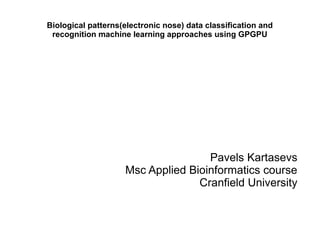Msc presentation Bioinformatics
- 1. Biological patterns(electronic nose) data classification and recognition machine learning approaches using GPGPU Pavels Kartasevs Msc Applied Bioinformatics course Cranfield University
- 2. Contents ˇń Electronic nose ˇń SVM and ANN ˇń Comparison of developed solution ˇń Heterogeneous processing ˇń Results ˇń Further improvements and conclusions
- 3. Problem description ˇń Prediction tools allows to analyze information from different sources ˇń Application: Meat spoilage prediction ˇń Meat spoilage problem (from manufacturer to producer) ˇń Fast enough solution and availability of free software
- 4. Meat spoilage ˇń Problem that can impact health ˇń Cause ¨C many different bacteria ˇń Sensory panel/laboratory analysis disadvantage ˇń Automatic analysis tools
- 5. Electronic nose ˇń Wide emerging field of cheap analysis devices ˇń Can be used for food science ˇń Automatic food quality determination
- 6. Electronic nose in prediction of meat spoilage ˇń Electronic nose generates data ˇń Low cost of the device ˇń Fast result ˇń E-nose results interpretation
- 7. SVM and Neural networks ˇń SVM Support vector machines are relatively new form of supervised machine learning. ˇń Artificial neural networks Artificial neural network by their model mimics human brain structure.
- 8. Difference between SVM and ANN ˇń SVM is fast ˇń Must preform grid search to find optimum solution ˇń Construct mathematical model of problem ˇń ANN learns, opposite to SVM ˇń Can work efficiently than SVM ˇń Processing speed depends on neuron count
- 9. SVM Performance comparison ensembleSVM_Count_ALL.R CPP_BIO Program 0 50 100 150 200 250 300 350 112 10 308 19 "Intel? Xeon(R) CPU X5492 @ 3.40GHz ˇÁ 8 DDR2 800 Mhz, Ubuntu 64-bit" Core i5-3210M / 4 Gb DDR3 Minutes
- 10. Implementation ˇń To get such speed all application/algorithm was reimplemented in C/C++ programming language which is the fastest programming language ˇń LibSVM C/C++ library
- 11. Prediction performance of R SVM 1 iterations, C param. from 1 to 50 with step 1, gamma from 0.1 to 10 with step 0.1, 80 SVM Time 60 min. Time 6.5 min.
- 12. GPU as co-processor ˇń Gpu is good on parallel computations ˇń GPU memory latency ˇń GPU library call latency ˇń
- 13. GPU libraries results Easy-cpu Easy-gpu Svm-train(cpu) Gpusvm-0.2 0 5 10 15 20 25 30 35 Processing time of 2Mb beef_fillets_fitr data Library Time(Seconds) Why is GPU slower?
- 14. GPU Ensemble ˇń Due to small data amount running one SVM on the GPU in inefficient ˇń But using GPU structure is making sense to run ensemble of SVM on the GPU in parallel
- 15. Re-implementation of libsvm on the GPU ˇń 2 different approaches Target NVIDIA ˇ°FERMIˇ± GPU Target ALL NVIDIA GPU
- 16. GPU re-implementation results ˇń Full GPU processing time: 1 minute vs 12 seconds on the CPU ˇń As accurate as CPU
- 17. GPU re-implementation results(2) ˇń Heterogeneous GPU processing cpu gpu 0 0.5 1 1.5 2 2.5 1.8 2 Time (seconds) GPU implementation is slower by 10%
- 18. GPU re-implementation results(3) 30.00% 70.00% Time performing by CPU to calaulate SVM matrix SVM Kernel calculation Other computing SVM Kernel matrix calculation on GPU saves ~30% of the CPU time, CPU is free to do other calculations
- 19. Solution for Graphical User Interface 1 2 3 3 4
- 20. Future improvements ˇń Further improvements of solution might include: ˇń Re-implement solution fully in Java languarge to make portable and library and platform independent ˇń Add Web-interface to the solution ˇń Write installation application to easy install solution
- 21. Conclusions ˇń Implemented solution is 10 times faster, than existing R framework solution ˇń Graphical interface implemented ˇń Different analysis types ˇń Heterogeneous computing





















